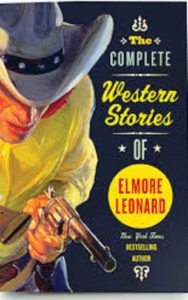Book Review: The Complete Western Stories of Elmore Leonard by Elmore Leonard
Elmore John Leonard Jr. (1925-2013) started his career as a professional writer by producing short Western stories for the pulp magazines. According to the introduction, Mr. Leonard’s first attempt was not very good and was rejected, whereupon he decided that next time he would do his research first. He focused on the Arizona Territory, because that part of the country had a strong draw for him, and he liked the Apaches best of the various tribes of Native Americans.
This volume presents the bulk of the stories in order of publication, rather than when they were written. Thus it begins with Elmore Leonard’s first published work, “Trail of the Apache.” Indian agent Travisin does his best to keep his Apache charges peaceful and moderately satisfied. He keeps his wits sharp through a bet with his lead scout Gatito that if the other man can ever touch his knife to Travisin’s back, he will win a bottle of whiskey. For the last two years, Gatito has not had alcohol.
The trouble arrives with Travisin’s new trainee, Lieutenant De Both. De Both himself is a decent enough fellow, though green in the ways of the West. But he’s escorting a band of Apache from another reservation, led by the renegade Pillo. The Army, in its infinite wisdom, has decided that Pillo and his rowdy comrades should be separated from their wives and families on Travisin’s reservation to calm them down.
To no one’s surprise, Pillo and his men are soon off the reservation with Gatito, and looking to gather other renegades to restart the Indian Wars. It’s up to Travisin, De Bolt, and the tracker known as Fry to stop them.
By the end of the 1950s, the pulp magazines had died, and the market for short Westerns had dried up. Mr. Leonard switched to primarily doing crime stories (You may remember Get Shorty.) But every so often, a Western collection would ask him to contribute, so there’s not quite a handful of such late stories. The last one published was “Hurrah for Captain Early!” which takes place in a small Arizona town which is having a return celebration for its hometown hero of the recent Spanish-American War.
The main character is Bo Catlett, a cavalryman who also served in the war. But since Mr. Catlett is black, there are those who don’t believe that he’s a veteran. In fact, they don’t believe that Mr. Catlett should be in town at all. And possibly not breathing. But Sergeant Major Bo Catlett has something to return to Captain Early, and maybe it would be okay if there was a little blood of an ignorant fool on it.
Like the other late-period stories, this one contains strong language that wasn’t allowed in the magazines, as well as the period racism. Taking place in the twilight of the Old West, it’s a suitable and somewhat cynical endpiece.
Of special interest to movie fans are the stories “Three-Ten to Yuma” and “The Captives” (which became The Tall T.) Both were considerably expanded from their original short format. In the former tale, a deputy marshal tries to get his prisoner aboard the title train with them both still alive despite their respective enemies. In the latter, a rancher who’s lost his horse hitches a ride aboard a stagecoach–which is promptly captured by outlaws, and he must use his wits to keep himself and at least one other passenger alive. Both are exciting and suspenseful.
Mr. Leonard was no stranger to dark humor, the best example of this in the current volume being “Cavalry Boots” in which a cowardly deserter becomes honored as the hero of a battle. Mostly because he’s not around to dispute it, but partially because he accidentally did save the day.
This edition has an extra story at the end, “The Treasure of Mungo’s Landing”, which wasn’t in the first edition because it couldn’t be proved it existed. Tracking down clues, it was discovered to have been printed under the wrong author’s name (Leonard Elmore) and in a different magazine than believed. The story itself is a nice tale of a man who discovers a robbery is about to be committed, and stops it only to be accused of the crime himself. The bad guy would have gotten away if he hadn’t let his greed and gloating get away with his common sense.
It’s thirty-one fine stories in all, ranging from talented newcomer quality to very good. There’s period depiction of Native Americans (not usually entirely negative) and some period sexism (plus a couple of attempted rapes.)
Recommended for Western fans, Elmore Leonard fans and fans of the TV series Justified, which was based on Mr. Leonard’s work.
Let’s have a video of the opening to the 1957 film of 3:10 to Yuma.

